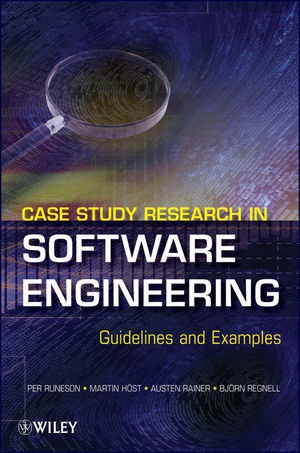Read more
Informationen zum Autor Dr. Austen Rainer is a Senior Lecturer in the School of Computer Science at the University of Hertfordshire. He is an active member of the Centre for Empirical Software Process Research (CESPR) and teaches several courses?in the BSc(Hons) and MSc degree programs. Dr. Per Runeson is leader of the Software Engineering Research Group at Lund University, as well as Research Director for EASE - Embedded Applications Software Engineering. He is a Senior Researcher at Sony Ericsson, where he fulfills his role as a verification advisor. His research focuses on efficient verification and validation processes. Dr. Martin Höst is Director of the M.Sc. Programme in Computer Science and Engineering at Lund University and a member of the Software Engineering Research Group (SERG). Dr. Björn Regnell is a professor of Software Engineering at Lund University's Department of Computer Science and Vice Dean of Research at the Faculty of Engineering, LTH. His research interests include market-driven software development, requirements engineering, software quality, software innovation, software product management, and empirical research methods. Klappentext Based on their own experiences of in-depth case studies of software projects in international corporations, in this book the authors present detailed practical guidelines on the preparation, conduct, design and reporting of case studies of software engineering. This is the first software engineering specific book on the case study research method. Zusammenfassung This is the first software engineering specific book on the case study research method. Based on the authors' own experiences of in-depth case studies of software projects in international corporations, the book presents detailed practical guidelines on the preparation, conduct, design, and reporting of case studies of software engineering. Inhaltsverzeichnis FOREWORD xiii PREFACE xv ACKNOWLEDGMENTS xvii PART I CASE STUDY METHODOLOGY 1 INTRODUCTION 3 1.1 What is a Case Study? 3 1.2 A Brief History of Case Studies in Software Engineering 5 1.3 Why a Book on Case Studies of Software Engineering? 6 1.4 Conclusion 9 2 BACKGROUND AND DEFINITION OF CONCEPTS 11 2.1 Introduction 11 2.2 Research Strategies 11 2.3 Characteristics of Research Strategies 13 2.3.1 Purpose 13 2.3.2 Control and Data 14 2.3.3 Triangulation 15 2.3.4 Replication 16 2.3.5 Inductive and Deductive Enquiries 16 2.4 What Makes a Good Case Study? 17 2.5 When is the Case Study Strategy Feasible? 19 2.6 Case Study Research Process 20 2.7 Conclusion 21 3 DESIGN OF THE CASE STUDY 23 3.1 Introduction 23 3.2 Elements of the Case Study Design 24 3.2.1 Rationale for the Study 24 3.2.2 Objective of the Study 24 3.2.3 Cases and Units of Analyses 26 3.2.4 Theoretical Framework 29 3.2.5 Research Questions 30 3.2.6 Propositions and Hypotheses 31 3.2.7 Concepts 32 3.2.8 Methods of Data Collection 32 3.2.9 Methods of Data Analysis 33 3.2.10 Case Selection 33 3.2.11 Selection of Data 35 3.2.12 Data Definition and Data Storage 36 3.2.13 Quality Control and Assurance 36 3.2.14 Maintaining the Case Study Protocol 37 3.2.15 Reporting and Disseminating the Case Study 38 3.3 Legal, Ethical, and Professional Issues 40 3.4 Conclusion 45 4 DATA COLLECTION 47 4.1 Introduction 47 4.2 Different Types of Data Source 47 4.2.1 Classification of Data Sources 47 4.2.2 Data Source Selection 49 4.3 Interviews 50 4.3.1 Planning Interviews 50 4.3.2 The Interview Session 52 4.3.3 Postinterview Activities 53 4.4 Focus groups 54 4.5 ...

